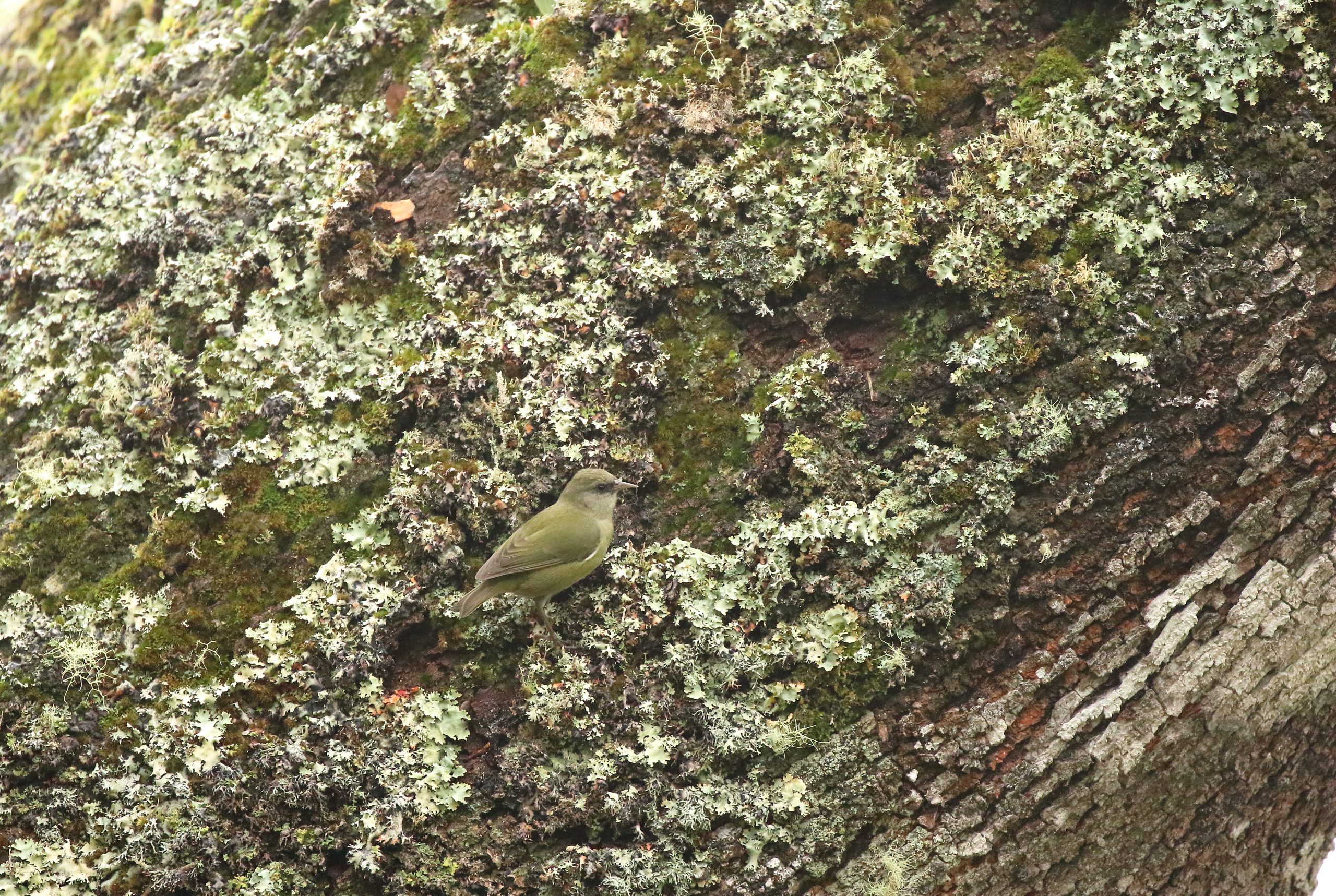ʻAlawī (Hawaiʻi Creeper)

Names
- ʻŌlelo Hawaiʻi; ʻAlawī
- Common: Hawai‘i creeper
- Scientific: Oreomystis (Loxops) mana
Song
Conservation Status
- Federally Listed as Endangered
- State Listed as Endangered
- State Recognized as Endemic
- NatureServe Heritage Ranking G2—Imperiled
- IUCN Red List Ranking—Endangered
- Revised Recovery Plan for Hawaiian Forest Birds—USFWS 2006
Species Information

ʻAlawī or Hawaiʻi Creeper. PC: Bret Mossman
The Hawai‘i creeper is a small, discreet Hawaiian honeycreeper (Family: Fringillidae) endemic to the island of Hawai‘i. Adults are predominately olive-green above, dull buff below, and have a dark gray mask extending around the eyes; males are brighter. Their similarity to Hawai‘i ‘amakihi (Hemignathes virens), Hawai‘i ‘ākepa (Loxops coccineus coccineus), and introduced Japanese white-eyes (Zosterops japonicus) complicates field identification. Unlike many Hawaiian forest birds, their life history is well known. Outside the breeding season, they frequently joins hunting parties made of several species and forages over home ranges that average 11 hectares (17.3 acres). They glean insects, spiders, and other invertebrates from the branches, trunks, and foliage of live ‘ōhi‘a (Metrosideros polymorpha) and koa (Acacia koa) trees. Most nests are open cup structures, but about 15 percent are placed in cavities or in bark crevices. Females build nests, incubate eggs, and brood nestlings. Males deliver food to the female on and off the nest. Both parents feed the young for approximately one month. Hawai‘i creepers re-nest after nest failures and pairs may raise two sets of offspring in a season. Nest success is very low, but adults have high annual survival.
Distribution
Occurs in four disjunct populations above 1,500 meters (5,000 feet) on the island of Hawai‘i. Historically occurred across the island above 1,070 meters (3,500 feet) elevation.
Habitat
Most commonly in mesic and wet forests dominated by ‘ōhi‘a and koa, with a subcanopy of ‘ōlapa (Cheirodendron trigynum), pūkiawe (Styphelia tameiameiae), ‘ōhelo (Vaccinium spp.), ‘akala (Rubus hawaiiensis), kōlea (Myrsine spp.), kāwa‘u (Ilex anomala), and hapu‘u tree ferns (Cibotium spp.). Habitat conditions vary across the species’ range, with much of it degraded by grazing ungulates, especially feral pigs. Most of the current range of the Hawai‘i creeper is within the boundaries of State and Federally owned lands
Threats
- Predation. Nest success is very low (11 to 50 percent) and rat (Rattus spp.) predation may be partially responsible. Hawai‘i creepers place their nests near the main trunks of trees which may facilitate predation by rats.
- Disease. The Hawai‘i creeper’s absence below 1,350 meters (4,500 feet) elevation suggests that it may be particularly susceptible to mosquito-borne avian disease.
- Habitat loss and degradation. Logging and grazing ungulates have reduced, degraded, and fragmented suitable forest habitats. Habitat fragmentation may be a dispersal barrier preventing or restricting recolonization of the species’ former range.
- Competition. Competition with Japanese white-eyes (Zosterops japonicus) may negatively affect Hawai‘i creepers.
Additional Resources
For more information and references visit the DLNR State Wildlife Action Plan factsheets. DOFAWʻs species pages and State Wildlife Action Plan fact sheets are provided for general information and are not meant to be a citable, original source of data. If you are a student, researcher, or writer looking for a citable source, please explore the references below or find other original data sources, rather than citing these webpages. The references below were provided by the authors of the State Wildlife Action Plan fact sheets at the time of drafting:
- IUCN Red List of Threatened Species. 2015. Version 2014.3. Available at: www.iucnredlist.org. (Accessed May 2015).
- Lepson JK, Woodworth BL. 2001. Hawai‘i creeper (Oreomystis mana). In The Birds of North America, No. 680 (A. Poole and Fr. Gill, eds.). Philadelphia, (PA): The Academy of Natural Sciences; and Washington DC: The American Ornithologists’ Union.
- Scott JM, Mountainspring S, Ramsey FL, Kepler CB. 1986. Forest bird communities of the Hawaiian islands: their dynamics, ecology and conservation. Lawrence, (KS): Cooper Ornithological Society.
- U.S. Fish and Wildlife Service. 2006. Revised Recovery plan for Hawaiian forest birds. Portland, (OR): U.S. Fish and Wildlife Service.




